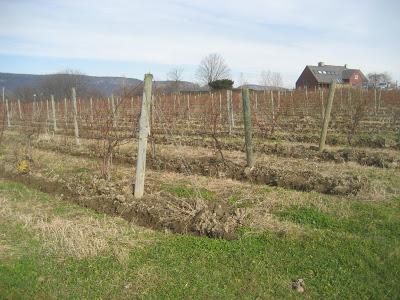
Back in the Fall I strolled down the vineyards at Whitecliff with Michael Migliore and we chatted about dirt. Really, the type of soil found at his vineyard, what grows well in the soil and why. It was very enlightening discussion. Not only does the soil contribute to the grapes in your glass, but it's important to graft the vine on the proper Rootstock that grows well in that type of soil. So many factors a vineyard manager has to take into consideration when planting a vineyard and where to plant what kind of grapes.
Below is an excerpt of my conversation with Michael. To read the entire conversation where he talks about the soil at Whitecliff and his new vineyard at Olana. why certain grapes are planted in certain places and the Riparia Rootstock experiment, click the link at the bottom and download the 6 page e-book.
Michael: We're talking soil types of which at Whitecliff here there are 3 soil types. We're standing on the highest point of our vineyard here and this is Castille soil. It's made up of fragments of shale, sandstone, clay and quartz conglomerate. We're very near a shale outcrop so it will be predominately shale up here.
Debbie: So what vines are growing here?
Michael: This is Pinot Noir and this is Clone 667. We grow a number of different clones of Pinot. 114, 113, are the predominant types that we grow. Some clone 29 also, the Pommard clone.
Debbie: Now tell me why Pinot Noir in this soil?
Michael: Ah, that's a very good question. This is my best site on our farm right here. It's south facing, it has perfect drainage. Grapevines do not like wet feet. If you could see what we're looking at right now, it's made up of lots of small stones and shale so it drains very, very quickly, so because of the aspect ratio of the slope of the hillside it gets plenty of sunshine. This was the site that we just got 7 tons to the acre of Pinot Noir, a record yield for us.(Harvest 2016) We like that very much. Whereas other soil types on my property are Churchville, and that's on the lower section of our vineyard right over there and it extends over about halfway into field 3 that we're looking at right now. That's a heavier clay with a lot worse drainage and what we see if we looked underneath the soil out there, we have drainage tile that's every 20 feet in order to aid in getting the water away from the roots of the grapevines. You can farm it, you can see we got a great yield, we actually got over 11 tons of Chardonnay out there on Churchville soil, and it has limitations because it tends to be wet. You can't get into the field as quickly with machinery after a heavy rain, and as I said we had to put drainage tile in to keep the soil from getting waterlogged. Then the third type of soil that we have is Cayuga and it runs half of the large field below. That's characterized by a gravelly loam. Glaciers came ten thousand years ago, as the glacier retreated it deposited all of this type material which is a lot higher in sand, a lot lower in clay content and has a lot of quartz material scattered throughout the soil profile. That's a very deep layer. It extends down to 10 feet before you hit a hard pan. Underneath that you'll hit a hard clay, but the drainage is very, very good throughout that area.
Click here to get e-book and learn about the different soils, along with rootstock and how it impacts what what is grown where in the Hudson Valley.
